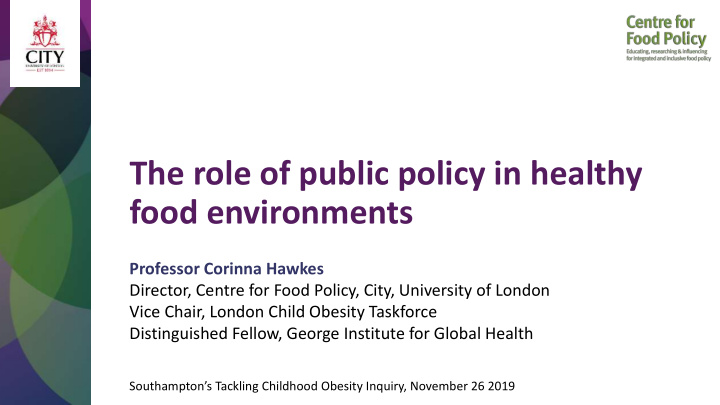



The role of public policy in healthy food environments Professor Corinna Hawkes Director, Centre for Food Policy, City, University of London Vice Chair, London Child Obesity Taskforce Distinguished Fellow, George Institute for Global Health Southampton’s Tackling Childhood Obesity Inquiry, November 26 2019
Vision: what is a healthy food environment? Affordable Available Acceptable Appealing
How can national policy change these food environments?
2. Policies for shops 1. Policies on quality of food supply 3. Policies for schools and other public institutions $4.99 National policy $6.99 can change environments to support norms change for people & businesses 5. Policies for labelling 5. Policies for marketing 4. Policies for price
Six key food environment policies
What are UK national policies doing to change food environments? Childhood Obesity Plan Ch.1-3 Earlier policies Labelling Mandatory calorie labelling OOH Traffic light labelling Public School food standards School Fruit Scheme institutions Healthy rating scheme for primary schools Universal free school meals KS1 School breakfast funding Guidance on food for early years Fiscal Soft drinks industry levy Healthy Start vouchers Change4Life money-off vouchers Marketing Consulting on further advertising restrictions Broadcast advertising restrictions to Ending price, volume & place promotions on u16s unhealthy foods Change4Life related activities Food supply Target to reduce sugar by 20% in childrens foods Salt reduction targets Calorie reformulation programme Energy drinks ban for u16s Improve content of baby food Food retailing
What do we know about impact in practice? • Labelling: Impacts vary with consumer characteristics, context & type of label but consistent effect is on “reformulation” • Schools: Improve food offer but may be undermined by food environment outside of schools and at home • Taxes: Evidence from Mexico suggests 6.3% reduction in the observed purchases of SSBs in 2014 • Marketing restrictions: Effective in reducing exposure on restricted channels but not more broadly; evidence from Chile will be critical • Reformulation: Clear impacts on salt levels in food if stringent enough targets
What’s missing at the national level? (1) Retail & neighbourhood policies A. Neighbourhood planning and infrastructure 1. Zoning, licensing e.g. zoning prohibitions 2. Financial (dis) incentives e.g. business rate reductions, investment in supermarkets 3. Restricting HFSS marketing on city transport and facilities B. Alternative food provisioning models (e.g. farmers markets, urban gardens, CSA) 4. Permits, subsidies, investment and/or business support for alternative retailing 5. Support for development and maintenance of urban agriculture community gardens 6. Engaging with community organisations, food banks etc, to provide more nutritious foods C. Inside store environments 7. Certification schemes, guidance and/or partnerships to incentivise retailers 8. Support services for small businesses to change offer 9. Regulations and legislation to reduce the appeal of HFSS foods by retailers and food outlets
Example: neighbourhood planning/infrastructure • Zoning, licensing: Ban on new takeaway outlets from opening within 400 metres of schools in Waltham Forest London • Financial incentives : Food Retail Expansion to Support Health Program (FRESH) in NYC provides financial and zoning incentives (e.g. exemption from standard business taxes) to promote neighbourhood grocery stores offering fresh foods in under-served communities
Example: alternative food provisioning • Permits, subsidies, business support – Curitiba, Brazil • “Armazê m da Famî lia ” (“family shop”) enables families enroll to access 33 stores selling foods 33% cheaper • Family Sacolā o Programme provides permits to distribute fruits and vegetables at a single price maximum (40% lower than conventional markets); • Our Fair (Feria)” markets), fruits and vegetables sold at a single price per kilo (at least 40% cheaper ) from family farmer cooperatives
• Support for urban agriculture/community gardening • Micro-vegetable gardening programme in low-income neighbourhoods in Antananarivo (Madagascar) • Micro-gardening on standing tables by low income women in Dakar, Senegal • Participatory Urban Agriculture Program in Quito, Ecuador, with 4000 allotments and products sold through local markets
Example: Inside stores and outlets • Certification: The Healthier Catering Commitment for London encourages businesses to commit to meeting specific requirements for healthier options by awarding them with the Healthy Catering Commitment. • Regulations and legislation. Around 12 cities in the US (many in California) require all fast food outlets to make water, sparkling or flavoured water, with no added natural or artificial sweeteners, milk or non- dairy milk alternatives the default beverage in children’s meal
What’s missing? (2) Accounting for people’s lived experience of food environments
“We live in a one -bedroom high-rise flat on the sixth floor. The lift is often broken, so my mum has to carry me and the buggy to the top” “I am a fussy eater so Mum no longer tries to give me fruits and “I sleep for between five and vegetables and gives me the seven hours each night. My processed snacks I ask for. These are sleep is often disrupted by cheaper and more convenient for noise in our building.“ Mum to buy” “We travel down the high street to nursery “Fruits and healthy snacks and my mum gets me a are available at nursery, but I snack“ don’t like eating them – I’d rather eat the processed snacks I’m used to at home.”
What’s missing? (3) Building locally on action & assets, meeting people where they are
17
Summary 1. A small number of national policies needed for norms change for people and businesses • Transforming food environments; reducing unhealthy intrusions into people’s lives 2. Policies that work for people start with understanding the context – the reality of people’s lives • What people are eating; why; how they respond to existing policy 3. Local government can both complement & lead national policy by building on assets with actions tailored to their populations • Local environments (retail/food service outlets/neighbourhoods); poverty; skills, care & support
Thank you corinna.hawkes@city.ac.uk @FoodPolicyCity @corinnahawkes
Recommend
More recommend